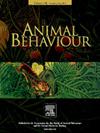一项关于埋葬甲虫的实验研究表明,更多的亲代照顾会导致更高的后代健康,但更多的照顾者却不会
IF 2.3
2区 生物学
Q2 BEHAVIORAL SCIENCES
引用次数: 0
摘要
动物在繁殖过程中有各种形式的合作。在近亲选择起作用的合作繁殖系统中,帮助行为的好处,比如抚养同种物种的后代,得到了很好的研究。然而,对于由多个不相关的个体共同繁殖组成的群体繁殖来说,这种好处和亲代照顾的影响仍然知之甚少。因此,本研究以埋葬甲虫(Nicrophorus vespilloides)为研究对象,探讨了群体繁殖和亲代照顾对繁殖成功率和后代性状的综合影响。埋葬甲虫是一种成对或群体繁殖的物种,在幼虫孵化前和孵化后为幼虫提供照顾。通过亲子关系分析,考察了公共群体的生殖份额。将单个胴体分配给两对(集体繁殖)或一对(配对繁殖)的甲虫繁殖组,从而通过允许幼虫在有或没有育后护理(完全护理或半护理)的情况下饲养来操纵亲代处理,并观察它们的繁殖和后代表现。与成对繁殖相比,群体繁殖有望提高后代的发育,因为更多的繁殖者增加了对较大群体的合作照顾。与预期相反,群居群体产生的后代较小,但与成对繁殖群体相比,后代的数量相同。正如预测的那样,在两个繁殖群体中,缺乏育后照料导致后代较小,而与成对繁殖相比,缺乏育后照料并不会给群体繁殖带来相当大的成本。与从属群体相比,公共群体中的优势群体占繁殖的大部分,但与成对繁殖的雌性相比,优势群体和从属群体产生的幼虫要少得多。因此,群体繁殖的成本高于繁殖和后代健康的更多收益,因为更多的繁殖者不一定能为共享育雏群的后代提供更好的亲代照顾。本文章由计算机程序翻译,如有差异,请以英文原文为准。
More parental care leads to higher offspring fitness, but more carers do not: an experimental study in burying beetles
Animals have various forms of cooperation during breeding. The benefits of helping behaviour, such as raising the young of conspecifics, are well studied in cooperative breeding systems, where kin selection plays a role. However, for communal breeding, which consists of multiple, unrelated individuals with shared reproduction, such benefits and the impact of parental care remain poorly understood. Thus, in this study, the combined effects of communal breeding and parental care on reproductive success and offspring traits were investigated using burying beetles, Nicrophorus vespilloides, which is a species that breeds in pairs or communal groups and provides care for larvae during pre and posthatching. The reproductive shares in communal groups were also examined through parentage analysis. Single carcass was allocated to breeding groups of either two pairs (communal breeding) or one pair (pair breeding) of beetles, thereby manipulating the parental treatment by allowing larvae to be raised in the presence or absence of posthatching care (full care versus half-care) for both breeding groups and observing their reproduction and offspring performance. Communal breeding was expected to enhance offspring development compared with pair breeding because of more breeders increasing cooperative care for larger communal broods. Contrary to expectations, communal groups produced smaller offspring but the same brood sizes compared with pair-breeding groups. As predicted, the absence of posthatching care resulted in smaller offspring in both breeding groups, whereas its absence did not impose considerable cost in communal breeding compared with pair breeding. Dominants in communal groups accounted for most reproduction compared with subordinates, but dominants and subordinates produced substantially fewer larvae compared with pair-breeding females. Therefore, communal breeding results in higher costs than more benefits for reproduction and offspring fitness, where more breeders may not necessarily provide enhanced total parental care to the offspring of shared broods.
求助全文
通过发布文献求助,成功后即可免费获取论文全文。
去求助
来源期刊

Animal Behaviour
生物-动物学
CiteScore
4.60
自引率
8.00%
发文量
236
审稿时长
10.2 weeks
期刊介绍:
Growing interest in behavioural biology and the international reputation of Animal Behaviour prompted an expansion to monthly publication in 1989. Animal Behaviour continues to be the journal of choice for biologists, ethologists, psychologists, physiologists, and veterinarians with an interest in the subject.
 求助内容:
求助内容: 应助结果提醒方式:
应助结果提醒方式:


